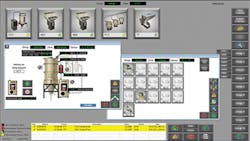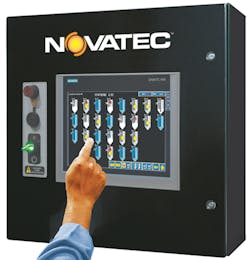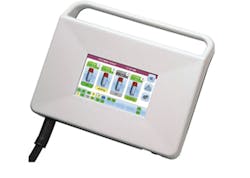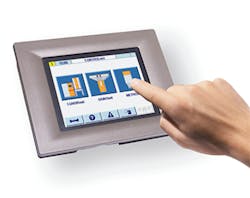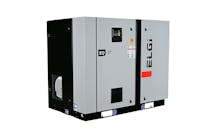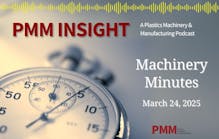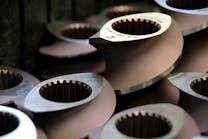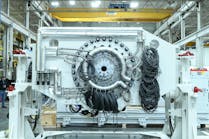Special Report: Plantwide control systems get stepped-up features
Plantwide and centralized materials-handling control systems are gaining features and functions. Five suppliers said they are improving control systems that handle groups of equipment designed to convey, heat, dry, blend and dose materials.
CONTROL UPGRADES FROM CONAIR
Auxiliary equipment maker Conair Group, Cranberry Township, Pa., is updating its plantwide and centralized materials-handling control systems for ease of use.
Later this year, Conair will release a new version of its ControlWorks system designed for plantwide management of all types of materials-handling equipment, including loaders, conveyors, blenders, dryers and heat-transfer units.
ControlWorks has been upgraded as Version 3.0. It will be enabled with supervisory control and data acquisition (SCADA). It monitors and controls most Conair equipment, allowing the user to change equipment set points, diagnose alarms and check the status of a machine from a central location, said Doug Brewster, product manager for conveying at Conair.
The combination of the control system's SCADA technology and a special identifier installed on most Conair auxiliaries will provide easy plug-and-play connectivity. The control will instantly recognize a new device when it is added to the system. The specifications and operating parameters of the added device will be automatically loaded by the control system. The user will be able to specify where the device belongs in the organizational hierarchy of ControlWorks. The system will have thousands of user-selectable icons that can be arranged on the touch screen to create a digital floor plan of a plant's manufacturing cells, Brewster said.
The new system will give users the ability to look at more than one piece of equipment at the same time. A user can view every piece of like equipment in the factory or look at all of the materials-handling equipment in place in a particular manufacturing cell.
ControlWorks 3.0 will come fully installed on a dedicated PC and will include the Microsoft SQL relational database management system, which allows the system to store process data from all connected equipment for analysis. Users can mine the data by creating queries that can analyze operating performance of a unit or group of units, reveal and track processing trends, or help the user establish maintenance schedules, Brewster said. Conair can provide a standard query template or users can write their own queries.
ControlWorks 3.0 users will be able to generate reports that show total consumption for a given resin, additive or group of materials by machine, shift or life of the project. The system will be able to store and retrieve material formulations, or show a list of alarms.
Conair's centralized control modules for conveying, drying, blending, feeding and storage operations can be connected to the ControlWorks factorywide control system. Conair is developing a Thermolator temperature-control module and a central water module.
CONAIR'S CENTRALIZED SYSTEMS
Conair is also updating its two centralized materials-handling control systems for improved functionality and ease of use. Earlier this year, the company rolled out a new version of its FLX entry-level control system for conveyors, vacuum pumps and material loaders, which uses a combination of distributed input/output (I/O) expansion modules and centralized I/O, and controls up to 128 receivers, 40 vacuum pumps and 256 source valves.
The new FLX-128 Plus system is scalable and has the same features as the previous web-enabled FLX-128 unit but now connects to additional materials-handling equipment from Conair. The FLX system incorporates an industrial Ethernet cable wire or Ethernet fiber optic wire to connect to the Internet for remote monitoring and control, said Brewster. FLX controls can simultaneously operate materials-handling systems of differing configurations, sizes and operating speeds through a single touch-screen control.
FLX-128 Plus can link to R-Pro, Conair's new dense-phase, resin-conveying system, developed to prevent equipment damage and other problems associated with high-speed, dilute-phase conveying. The R-Pro (Resin Protection) system, introduced at last year's NPE, uses pulses of air to move material at a fraction of the speed of a more conventional high-velocity conveying system, preventing the creation of dust and angel hair, Brewster said. Throughput and conveying distances are comparable to conventional systems. The user can adjust R-Pro's pump speed and valve speed to control the amount of material being transferred. A new energy-saving feature optimizes pump operation. R-Pro can now also store loader recipes, in addition to providing variable speed control of the pumps. The upgraded R-Pro can be operated through the FLX-128 Plus control, Brewster said.
Conair is also upgrading the capabilities of its larger materials-handling system, the ELS (Ethernet Loading system), which can control up to 500 receivers, 96 pumps and more than 1,000 source valves. The fully distributed control system, which currently incorporates Allen-Bradley controls architecture and components, will be upgraded with a similar level of process intelligence incorporated into the FLX-128 Plus unit, said Brewster. ELS, still in its first design iteration, will undergo an update to the operating platform. This will enable ELS' use with R-Pro and other materials-handling equipment.
NOVATEC TAKES CONTROL PLANTWIDE
Novatec Inc., Baltimore, earlier this year upgraded its FlexXpand FX2 centralized conveying control technology to manage the company's central drying systems and other auxiliary equipment.
The system, revamped as a plantwide control system with the update, incorporates Novatec's NovaNet equipment networking system, which allows FlexXpand FX2 to connect with up to four central dryers and up to 48 central drying hoppers. The new control can manage 32 Novatec weigh scale blenders as well as 160 receivers, 20 vacuum pumps and 36 other individual pieces of Novatec equipment.
The addition of NovaNet allows FlexXpand FX2 to control off-site systems, including up to two Novatec railcar unloaders and 12 silo sensors. It can link to material ID-proofing systems that confirm material connections at central distribution manifolds and filling stations. FX2 can also monitor downstream extrusion equipment, including cutters, pullers and saws. Connecting to centralized and stand-alone pieces of equipment is a major new capability, said Jim Zinski, VP of product technology.
"At its core, FlexXpand is a central conveying controller, but because its conveying control can span the entire facility, we decided it is a natural portal to provide access for operators looking to control or see the status of other pieces of equipment from a single location," Zinski said.
Novatec developed FXM2 expansion modules, which connect the controls from its other materials-handling devices to the FlexXpand FX2 control. Users can access a connected materials-handling device through the FX2 touch screen or remotely via a web browser from any networked computer or from a smartphone or tablet. When equipment is accessed remotely, notifications appear on the home screen of the equipment that's affected. Remote displays provide the full functionality, look and feel of the device being controlled.
Remote users can confirm whether a device is enabled or disabled, manage recipes, program material changes, view operating details (for example, monitor pump run life) and set up a device. The connectivity gives the user the ability to adjust the parameters of one materials-handling device from the home screen of a different device networked to the FlexXpand FX2, said Zinski. Users can view networked central drying systems or blenders without interrupting their operation or taking over the control.
In addition to the main control panel of the FlexXpand FX2 and the control screens on each piece of networked equipment, users have the option to wirelessly link up to four HMI stations to the controller.
Novatec offers FlexXpand FX2 in two base models, controlling up to five vacuum pumps and either 16 or 32 receivers. It is offered with a standard, 7-inch touch-screen HMI or optional 12-inch HMI panel.
Novatec will also introduce a new capability for its entry-level FlexTouch FTS conveying control. The system, which features a simpler function set and is designed for processors that do not operate highly complex molding cells, will have an option to link two FTS controls together. It does not incorporate the NovaNet technology, said Zinski.
UNA-DYN UPDATES RANGE OF CONTROLS
Universal Dynamics Inc., Woodbridge, Va., said its FACS-X factory acquisition and control system has updated modules that enhance its plantwide control of materials-handling and conveying systems.
The distributed-control process-management system, introduced at last year's NPE but commercially available since the beginning of the year, connects to more than a dozen modules that manage blenders, dryers, silo inventory and all equipment compatible with SPI communication protocols, said President Bill Goldfarb. The FACS-X system is composed of a two-wire power and communications network that makes the unit easy to install, as a separate single-phase power supply is not required.
New developments include enhancements to the PX Pump module and a VAX-SP pump controller interface that lets the user fully measure the vacuum operation of the materials-handling system. The basic pump controller comes with four inputs and four outputs, but now incorporates analog inputs, which allows the molder to optimize the operation of the pumps that convey the material.
"With pneumatic conveying, a molder has to be attentive regarding the speed of the material moving through the conveying system. Controlling conveying line velocity is important to prevent degradation of the material or degradation of the line through wear from filled or hard-to-convey materials. This is a fundamental reason why we have further developed this module," said Goldfarb.
The analog input, along with an on-board Pump Data-logging system, helps the user determine what might cause the loading system to work or fail. The enhanced VAX-SP display can show vacuum conditions throughout the loading cycle, and from cycle to cycle, which lets the user analyze the overall performance of the vacuum system, said Goldfarb.
Historical pump-operation data can be analyzed to maximize pump efficiency (and, therefore, conveying efficiency) by adjusting characteristics of the load cycle. The user can optimize the operation of the pump by determining baseline values for the vacuum during pre-actuation, conveying and purging. Deviation from the baseline can indicate a problem.
The molder can optimize the duration and intensity of the vacuum pump operation through each phase of the loading cycle. Doing so ensures that the purging step isn't extended, which wastes time and energy, or that materials conveying uses the correct level of energy, Goldfarb said. "Every moment the vacuum is operating but not delivering resin is waste," he said.
Up to eight modules — in which each module serves one type of equipment — can be connected to a FACS-X unit. FACS-X incorporates an SQL database, allowing it to collect data from auxiliary equipment that can then be made available to a plantwide information system.
Una-Dyn also offers a central dryer concept called AutoMate that enhances energy management and control of the system using its Focus control platform. A typical central dryer module, featuring one dehumidifier supplied with a FocuProComm controller, gives the operator single point of control of the dryer and multiple subsidiary hoppers. The user can set operating parameters for each hopper, where each unit can then self-adjust the air flow to maintain the ideal conditions automatically.
Una-Dyn recently enhanced a simpler materials-handling control system. The Ready-to-Run system, the R2R, a lower-cost, pre-wired pump that connects to the vacuum lines and receivers of a manufacturing cell, can now be used with larger, more complex molding systems. R2R is designed using either a single vacuum line, making it available to a remote sequence valve manifold, or with up to four sequence valves built into the unit. Una-Dyn now offers a version of the R2R that incorporates the company's stand-alone, conventionally wired controller, called 24/7, designed to handle a variety of loading stations.
Una-Dyn mounted the 24/7 control, complete with its LCD controller to the R2R unit, which provides control for up to 16 remote loading stations. This is a simpler alternative to purchasing a host of sequence valves, controls and pumps and then configuring each device, Goldfarb said. Up to three R2R units can be connected to a FACS-X system; they can also work in a stand-alone configuration.
WITTMANN UPGRADES CONTROL OFFERINGS
Wittmann Battenfeld Inc., Torrington, Conn., this year introduced two central materials-handling control systems, for large-scale and for smaller operations respectively, said Nicholas Paradiso, engineering manager for material handling and auxiliaries.
The company's M7.3 IPC is a central pneumatic conveying control system for managing material from the silo to the dryer. It is configured to connect with up to 32 dryers with 240 drying hoppers using a Canbus networking connection. The centralized system can control one or multiple central vacuum pumps, and offers users expandability with plug-and-play hardware, said Paradiso.
The M7.3 IPC has a high-resolution touch-screen HMI. Software features include programs for materials-based visualization of the conveying system, graphical display of the vacuum loader and ability to adjust the conveying sequence or the loading time, said Paradiso. The network conveying control system also has a vacuum pump display that allows the user to select automatic switchover between either the main pump or the backup pump. The unit also features a graphical display of the central drying system allowing for complete control of drying temperatures, dew point readout and configurable drying parameters, said Paradiso.
All relevant control data and parameters collected by the M7.3 IPC control system can be transferred to a companywide enterprise resource planning and process data-monitoring system using an open standard OPC protocol. A number of configurable options are available for dealing with difficult-to-convey materials. For instance, a molder can choose to purge the line more frequently. Another option is to break the vacuum, which shakes material off of valves.
M7.3 IPC connects to the company's DryMax dryers using a network card. When linked, users can dial in ideal dryer process conditions, manage all drying hoppers networked to the dryer, and even record the dew point in the hopper for enhanced drying control.
Due to the configuration of the control system for M7.3 IPC, the unit cannot, at present, be connected to Wittmann Battenfeld's Gravimax blender line or Dosimax feeders, which are each configured with a separate control. M7.3 IPC features an SQL database allowing data collected from the unit to be read by another system, said Paradiso.
In June, Wittmann Battenfeld introduced its net5 TeachBox Basic, a graphical user-interface control that can manage up to 24 loader conveying stations, two vacuum circuits and up to four dryers.
The unit can control pump filter stations and suction valves, as well as up to four drying systems from the Aton plus series. Units linked to the net5 TeachBox Basic system are displayed in graphical form on a 4.7-inch touch screen, Paradiso said.
Net5 Teachbox Basic was designed to work with two pumps and a spare pump. Loaders can communicate with each other through net5 TeachBox Basic. The unit replaces the eMax unit, which handled two pumps but no spare, said Paradiso.
MOTAN CONTROL TO FILL BROADER PURPOSE
CONTROLnet is an Ethernet-based integrated materials-handling control system for plantwide control from Motan Inc., Plainwell, Mich., which is undergoing another development phase since its introduction in 2000, said Sales VP Scott Harris.
"The ability to communicate with our own range of materials-handling equipment is important with regard to interprocess communications, but customers are now asking that control systems also have the ability to connect to equipment from other suppliers. Users are also looking to generate process and production reports from a central location," said Harris.
Motan is working with a number of molding machine manufacturers to develop a standardized OPC UA interface that will allow for better communication and control among various types of equipment. The company is connecting its CONTROLnet technology with non-Motan equipment on a limited, case-by-case basis, said Carl Litherland, head of group marketing for Motan Holding GmbH, based in Konstanz, Germany.
"We are doing this now, it is an area of growth and it is not just the materials-handling suppliers anymore. It is the suppliers of automation, mold-temperature controls and primary machinery. From the earliest days, CONTROLnet has had a tie into other equipment, such as setting the start of a central dryer based on a signal from the injection molding machine or another source," Litherland said.
Through CONTROLnet's WEBpanel graphical touch-screen interface, Motan's other control systems, including its centralized system for drying (LUXORnet), conveying (METROnet) and mixing/dosing (GRAVInet) are able to communicate with other reporting and monitoring systems, with data presented in familiar software formats such as Microsoft Excel. New capabilities for CONTROLnet include a remote maintenance option that allows a user to analyze a piece of equipment and change operating parameters remotely via Ethernet connection.
The company's CONTROLnet now incorporates CONTROLreport, a new report generator that can document the performance of any piece of equipment communicating with it.
Mikell Knights, senior correspondent
mknights@plasticsmachinerymagazine.com
Contact:
Conair Group, 725-584-5500, www.conairgroup.com
Motan Inc., 269-685-1050, www.motan-colortronic.com/us
Novatec Inc., 410-789-4811, www.novatec.com
Universal Dynamics Inc., 703-490-7000, www.unadyn.com
Wittmann Battenfeld Inc., 860-496-9603, www.wittmann-group.com

